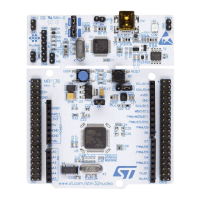Quick start UM1974
10/85 UM1974 Rev 9
5 Quick start
The STM32 Nucleo-144 board is a low-cost and easy-to-use development kit, used to
evaluate and start a development quickly with an STM32 microcontroller in LQFP144
package.
Before installing and using the product, accept the Evaluation Product License Agreement
from the www.st.com/epla webpage. For more information on the STM32 Nucleo-144 and
for demonstration software, visit the www.st.com/stm32nucleo
webpage.
5.1 Getting started
Follow the sequence below to configure the Nucleo-144 board and launch the
demonstration application (for components location refer to
Figure 4: Top layout):
1. Check jumper position on the board:
JP1 OFF (PWR-EXT) selected (see Section 6.4.1: Power supply input from ST-
LINK/V2-1 USB connector for more details)
JP3 on U5V (Power source) selected (for more details see Table 7: External power
sources)
JP5 ON (IDD) selected (for more details see Section 6.7: JP5 (I
DD
))
CN4 ON selected (for more details see Table 4: CN4 states of the jumpers)
2. For the correct identification of the device interfaces from the host PC and before
connecting the board, install the Nucleo USB driver available on the
www.st.com/stm32nucleo website.
3. To power the board connect the STM32 Nucleo-144 board to a PC with a USB cable
‘Type-A to Micro-B’ through the USB connector CN1 on the ST-LINK. As a result, the
green LED LD6 (PWR) and LD4 (COM) light up and the red LED LD3 blinks.
4. Press button B1 (left button).
5. Observe the blinking frequency of the three LEDs LD1 to LD3 changes, by clicking on
the button B1.
6. The software demonstration and the several software examples, that allow the user to
use the Nucleo features, are available at the www.st.com/stm32nucleo webpage.
7. Develop an application, using the available examples.

